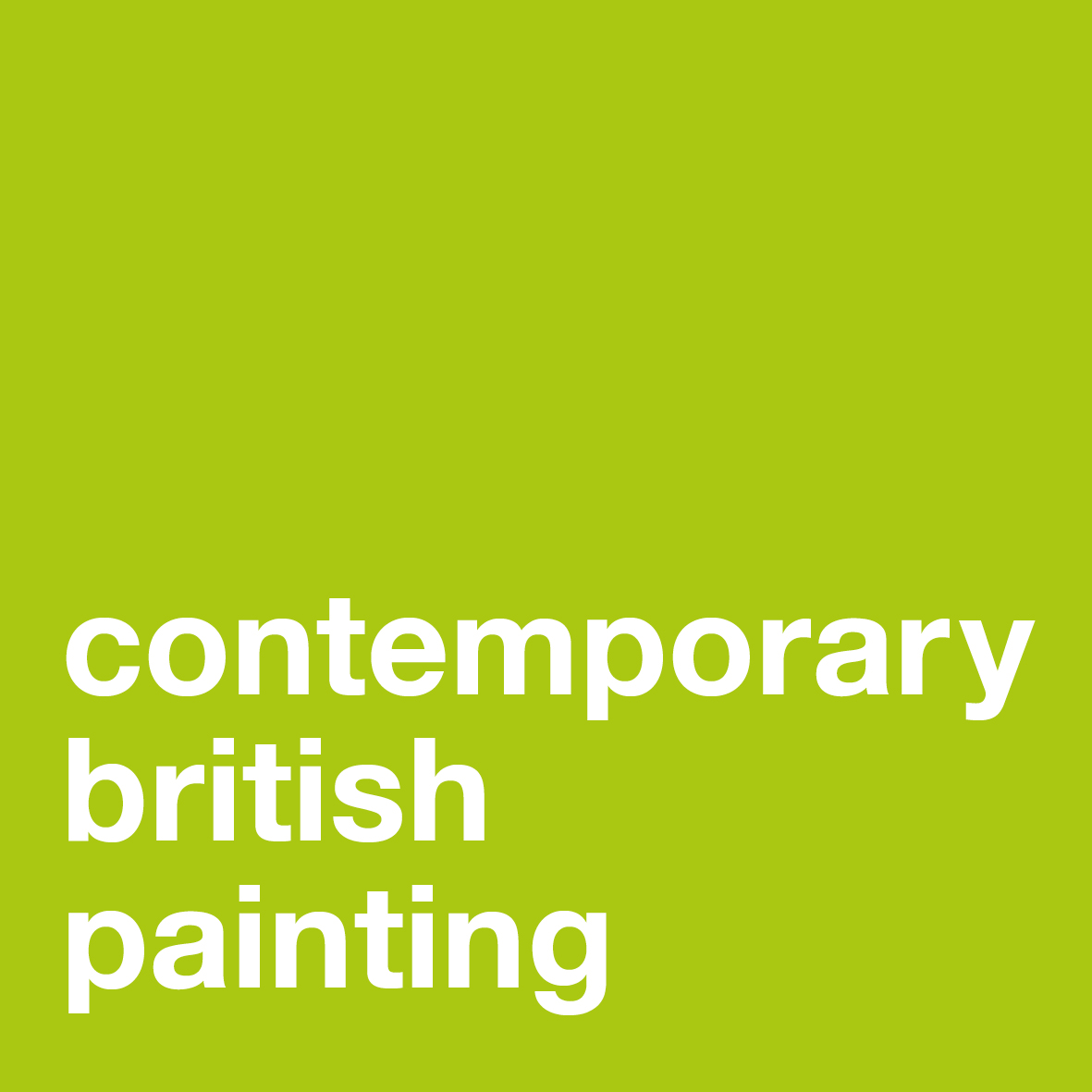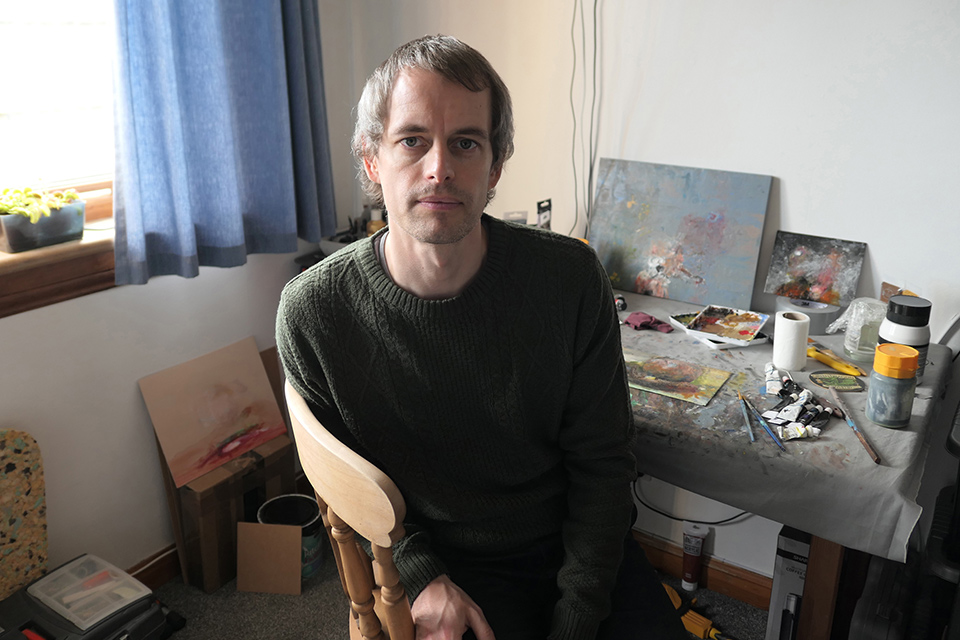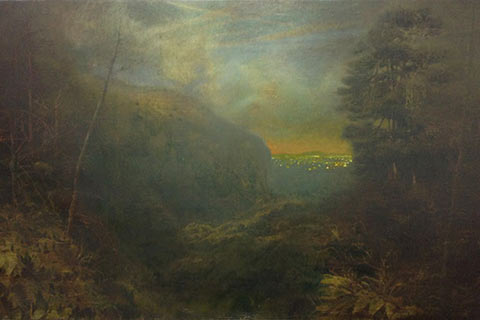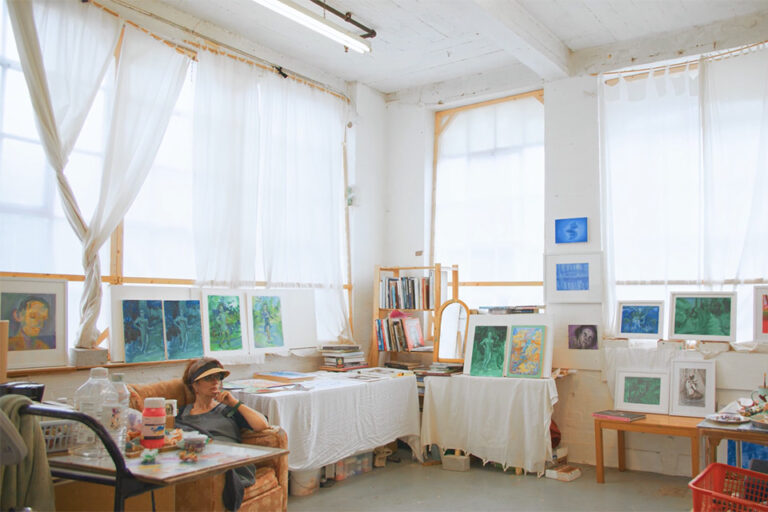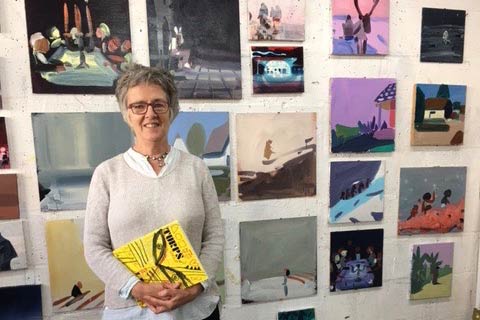Daniel H Bell: Artist of the Month
Artist of the Month November 2025:
Daniel H Bell, selected and interviewed by Paul Newman for CBP.
Daniel H Bell’s paintings are based on the physicality of humans and other animals. The ambiguous figures that appear in them stem from various personal encounters at home and out in nature. Bell works intuitively, embracing accidents, forging juxtapositions through a mixture of realism, caricature and abstraction.
He pushes together a mixture of substances (acrylic, oil, varnishes, gels) and uses the unpredictability of their interactions to help direct the work. The imagery that Bell creates usually veers toward the recognisable forms of human faces, native wildlife and anything that his subconscious drags up in between. There is always the presence of death and decay, with the fractured, metamorphic quality of his paintings hinting at environmental destruction as much as uncanny horror.
Daniel was awarded the Contemporary British Painting Prize in 2024.

CBP: Encountering your painting ignites evocative associations with seductive visceral decay, putrid and decadent. Human and animal forms shapeshift in and out of recognition in the fluidity of paint and medium experimentation. The work evokes a compelling sense of psychological interiority. What are the range of sources, imagery and ideas that instigate your paintings?
DHB: Usually it starts with just playing around with the paint. I have some ideas of what I want to do with each piece, but I don’t want to bring in fully-formed imagery too soon. I’ll introduce fragments from photos, and see what comes out of my head, and just keep things as undecided as possible. There is a lot of shape-shifting, that’s why I like paint so much – I’ll bring things into focus when I want to, but I enjoy the way things can hover abstractly the way they do in your mind.
Decay is a big part of it, as I’m really drawn to things that have been changed and damaged by time. There are tangible little things like this, that I’ve collected (or photographed) that show up in my work. There’s usually some sort of human presence tying in with this too, then that grey area where it’s more emotional and spontaneous.

CBP: There are some overt flora and fauna references, a frog and fungus for example that allude to close up scrutiny, recording and recalling an experience of nature. This real experience feels intuitively balanced with the notion of interiority mentioned above. Can you talk about this relationship between observed organic matter and the stuff of the mind in your work?
DHB: I spend a long time on each painting, coming and going to it over months, and working on it alongside others, all the while accumulating new bits and pieces of imagery to use. Plus, this all takes place in one little room, where I’m pretty much living amongst it all – everything’s within reach and everything is interacting. I need to get lost in it, and those real observed elements of nature are like little anchors along the way.
I love being outside, taking photos, looking through field guides, trying to learn as much as I can about the things I might paint. I want my work to be a bit baffling and mysterious, but there’s so much weirdness to be found everywhere anyway – that’s why I’m so obsessed with fungi, amphibians, spiders, insects etc. I don’t understand a lot of what’s going on in my head, and I don’t understand a lot of what I see, so it’s such an enjoyable process to try and turn all that into little rectangular images.
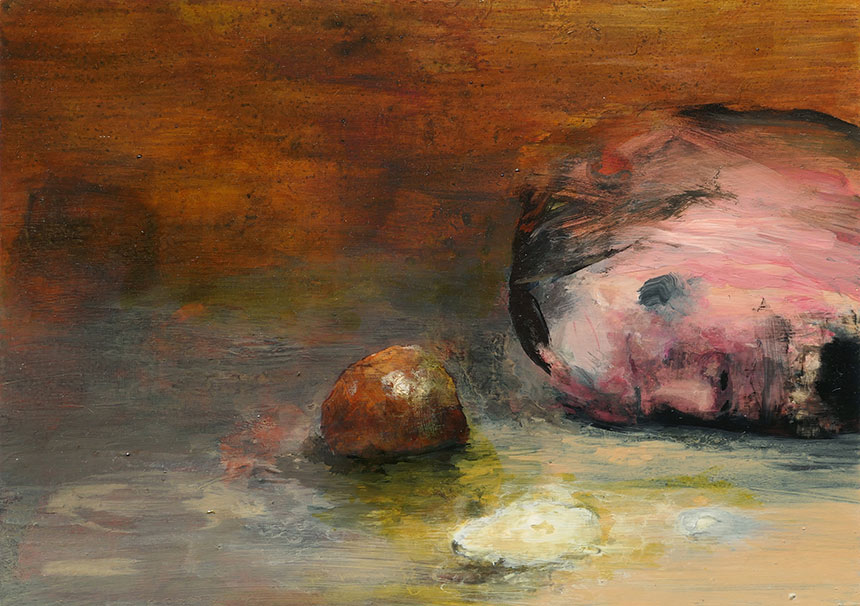

CBP: Max Ernst has been referred to as influential on your work by Louisa Buck, who wrote the essay for you as winner of the 2024 Contemporary British Painting Prize. Your interior worlds cross into surrealist landscape territory as discombobulated figurative terrains. Do you identify with your painting in this way? And are the other historical art influences imbedded in the work?
DHB: When I very first started painting it was the surrealists that drew me in, and Ernst’s work was particularly intriguing. But anything monstrous really, I found quite inspiring (Bosch, Grünewald, Goya) but I didn’t particularly think about all these paintings in terms of the subconscious. That’s something I’m much more aware of now, and something that I really try to explore.
I had several years of not painting, when my practice had gradually shifted into sculpture and installation. After that I got into video and animation. So the artists whose work I related to obviously changed a lot through that time, from Sigmar Polke and Paul McCarthy through to Jan Švankmajer, Yuri Norstein, Ladislaw Starewicz, the Quay Brothers etc. I came back into painting from a completely different angle, which is probably much more in line with the surrealists that I originally liked.

CBP: Ernst was known for his strangely tactile surfaces and development of the frottage technique. When I first saw your paintings in 2022 online as a selector for the CBP Prize, I was struck immediately by the exquisite intensity of their surfaces, which was naturally more pronounced experiencing them in the exhibition. There’s an exciting volatile alchemy to these intense textures and mutating imagery. It feels like reckless and fortuitous experimentation. Can you discuss some of your processes and the range of mediums you use?
DHB: Having spent so much time obsessed with tactile things (working with found objects and making little models) it’s the textures and the interactions of materials that really keeps me interested in painting. Each piece tends to be mainly acrylic, but there are always other mediums in there as well. For example, emulsion, oil paint, different types of varnish, wood stain, structure gel, filler, marker pen, fake blood etc. The paintings have lots of layers and often wait a while between each one, so I have chance to see how things interact and how they settle.
Even just watering things down can have a big effect, especially when that’s bumping up against a section that’s much thicker or more congealed. I particularly like working on the more detailed life-like elements of a painting when it’s at this precarious stage – sometimes it’s a lot of painstaking work for nothing (as it all bleeds away) but sometimes it can turn into something unexpectedly striking. It is reckless and fortuitous, but if you do it enough you begin to understand how to control it to a certain extent.
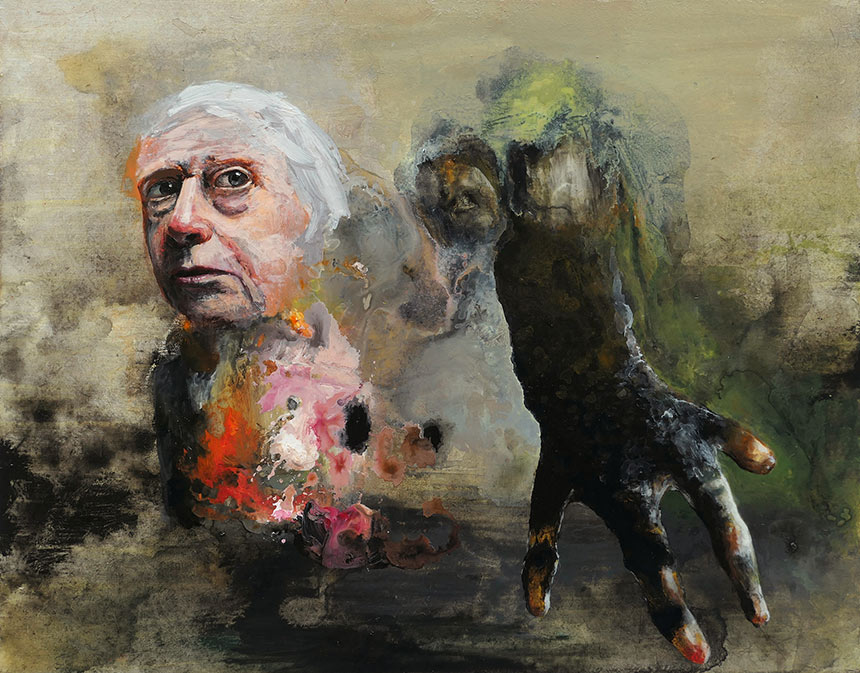
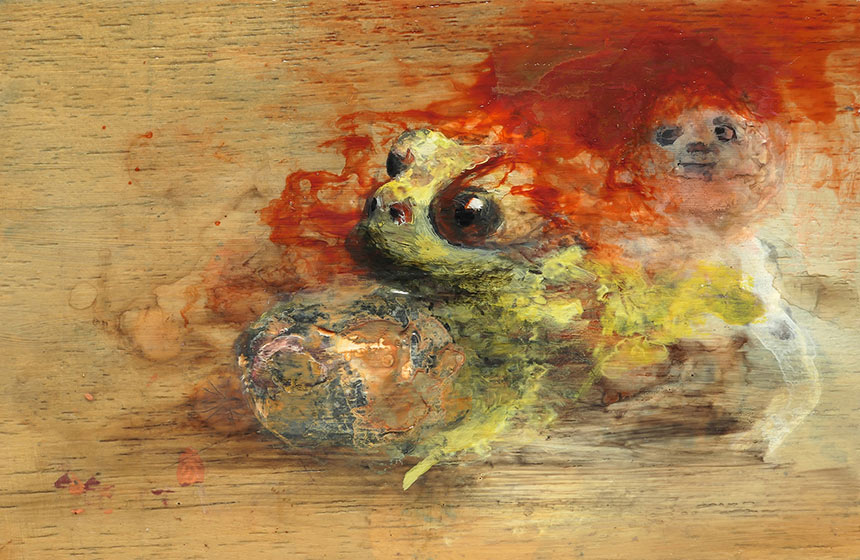
CBP: Is this experimentation built on traditional knowledge of paints, mediums and constructing paint surfaces, or has it always been more of a journey into the unknown, combining and clashing mediums and seeing what sticks?
DHB: The way I paint now, it’s definitely a journey into the unknown. I was a bit self-conscious about that at first, feeling I should be more structured, following some of the rules I learnt in art school all those years ago. But I find the combining and clashing of mediums exciting, I never quite know how much control I really have, and it feels like it’s coming much more directly from me.
Of course there are times when I’ve decided exactly what image I want to put down on the surface, and I sit there until I’ve painted it – but I still love the feeling of leaving things in limbo, coming back the next morning to see what the big muddled mess of different liquids had turned into overnight. I think that any traditional knowledge that I have kind of finds its way through anyway, and it’s more important to me to not let that get in the way of something more intuitive.
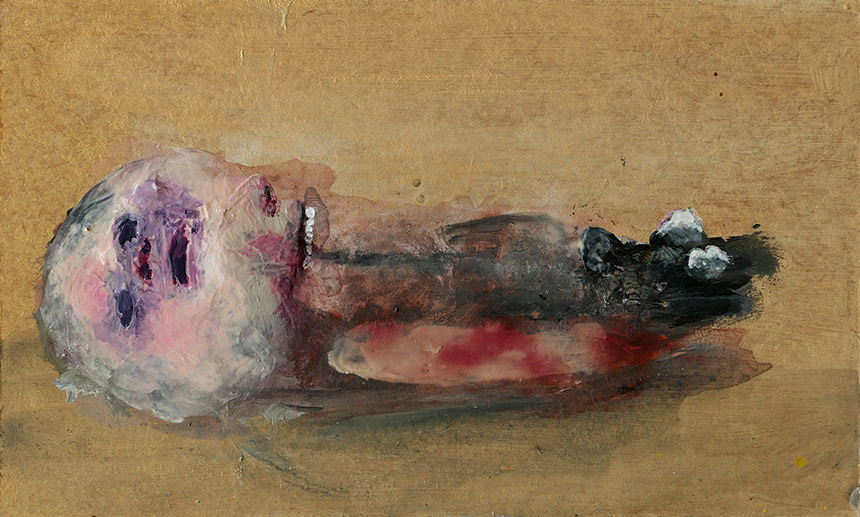
CBP: The dynamic uncertainty of the work is enhanced by shapeshifting figures that come in to focus with painterly detail from the soup of chemical stuff. It explores a classic push pull of figure ground relationships in painting. There’s also something abject and queasy about these forms and their unpredictability in what they might metamorphosis into next. I can relate to the unsettling transformations in john Carpenters The Thing, from 1982. Do you know intuitively when to pull the trigger and render a form into focus? Is it nearing the completion of the work. Or are there many other buried figurations underneath?
DHB: I suppose just like in The Thing I don’t know from whom/what or when something monstrous is going to burst out. I prefer it when it’s not too early on in the making of a painting, because I don’t want to feel like I’m proceeding too tentatively after that, trying not to ruin what I’ve got. Usually though, even if I’ve meticulously rendered an image that I wanted, I’ll keep going, chucking everything at it, in the hope that I get something that I’m even more pleased with.
I like the paintings that take ages to make, the ones that feel like they’ll never work. I never give up on a painting, I just pile more paint on, or get more rough and destructive with it – if it can hang in there long enough it can end up being the most interesting to look at. So there are nearly always figurations buried underneath, and the emphasis is always on mutation and metamorphosis so I’m happy to see where that leads me.


CBP: The small scale of these paintings feels significant with the sense of private interiority and fragility of emerging and submerging forms. This includes the intimate encounter with them by the viewer. Can you discuss the significance of the scale in the making of the work?
DHB: I make my work just sitting at a little table with a few paintings within reach at all times, so it’s quite intimate, and messy, and there’s a lot of cross-pollination. When it comes to showing them, I want people to move in close and really have a good look, to see the layers, textures and all the time that’s been condensed into each piece. I hope that the viewer can see how personal they are, and how they’ve emerged from quite a visceral interaction with the materials and subject matter.
I’ve never had a very big living or working space, so I’ve always tried not to accumulate too much stuff – and I really value small things anyway. I think things that are portable, that you can carry around with you and hold close, can feel very special. Hopefully my paintings have that kind of aura, more like little curiosities than anything too flashy.

CBP: For me your work also triggered an association with ‘Still Life’ 2001 by Sam Taylor Wood that depicts a video timelapse of decaying bowl of fruit in the style of a Flemish Still Life Painting. Can you talk about the notion of time, decay and death in your work?
DHB: Death and decay are important themes in my work. I mainly paint small things (plants, fungi, slugs, snails etc) so obviously with these, dying and rotting happen very quickly and frequently. They’re a good way of exploring much wider ideas about ageing and perishing, and I’m just really interested in seeing how things change. I have various bits and pieces laying around that I’ve collected on walks, so (just as with my paintings) there’s a lot of looking and waiting, and seeing what happens overnight, or in a week, and so on.
In my work, the decay and devastation is obviously twisted and pushed in all sorts of directions, but it’s something that’s lurking in the background for all of us. I might tackle it in quite a flippant or cartoonish way in my paintings, but I don’t think you need to be too literal to express how terrifyingly fragile all life is.

CBP: Like Sam Taylor Woods work, you also produce timelapse, stop motion animations that complement your paintings. Can you briefly discuss these, their origins and how they relate with the paintings?
DHB: I just find the idea of making a dead object start moving around utterly fascinating. As a child I was really frightened seeing Professor Yaffle come to life and climb down from the bookshelf, and then a few years later the disturbing White Rabbit in Švankmajer’s Alice. Those things really stuck with me, but it wasn’t until the early 2000s, when I first got a digital camera, that I was easily able to make that kind of thing. That was roughly the same time I drifted away from painting, and I saw the two disciplines as being completely separate at that point.
I really liked the tactile nature of model animation, and the emphasis on textures and surfaces. It ended up getting quite messy and I found myself using a lot of different materials that I ultimately realised could make for quite interesting paintings. So I started throwing things together on a flat surface instead, and before I knew it I was painting again. It became much more of a holistic practice, and paint even made its way more into the animations – duration and narrative became less important, because the videos just felt like slightly more lively paintings.
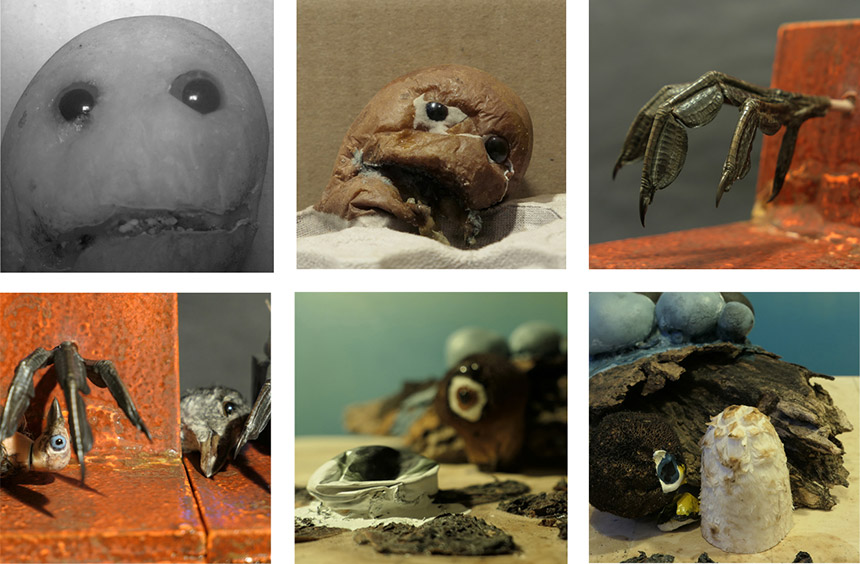
CBP: Can you describe a day of making in your studio and how you might have several paintings on the go simultaneously?
DHB: I’ll usually have a couple of paintings on my table, and several more scattered about the room – some with thick wet mixtures of stuff that will take days to dry, and others that are at a more detailed painting stage. I’ll paint whatever elements I feel most sure about, and then look around and see what else might work, on whichever surface jumps out at me. I’ll have a look through the photos that I’ve taken recently, or search for a particular image or object, then just start painting again.
It’s very easy to start following a bit of a formula though, or doing things that I know work. I have to remind myself that the paintings that (I think) are the most successful are the ones where I’ve done something that I’d never tried before. So I always endeavour to do at least one thing differently with each piece, forgetting what I might want the final image to look like and being a bit more foolhardy. Making constant little disruptions like that just keeps me on my toes, and hopefully makes for more interesting paintings.

Daniel H Bell studied Fine Art (Painting and Drawing) at Glasgow School of Art, and then Digital Practices at Norwich School of Art and Design. His work progressed through sculpture, video and installation before settling on stop-motion animation and ultimately a return to painting.
Bell was awarded the Contemporary British Painting Prize in 2024, having also been shortlisted in 2022. During this period his work has been included in The Horror! at Project 78 Gallery (St Leonards-on-Sea) AIR Open at Rogue Artists’ Studios (Manchester), Living With the Past at Cupola Contemporary Art (Sheffield), the Society of Scottish Artists Annual Exhibition and the Derwent Art Prize. He has previously shown his short films at the London Short Film Festival, Filmfest Dresden, Flatpack Festival (Birmingham), Another Hole in the Head Film Festival (San Francisco) and Antimatter Media Art (Victoria).
https://www.danielhbell.com
Videos: https://www.danielhbell.com/videos
Instagram: danielhbell_artist
